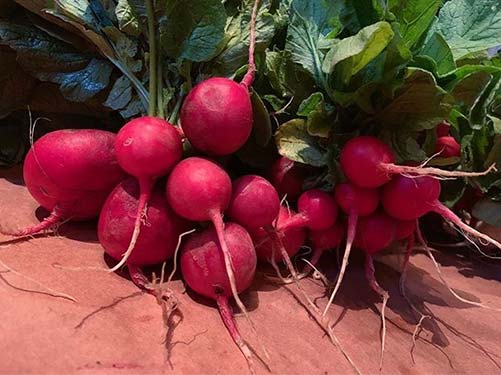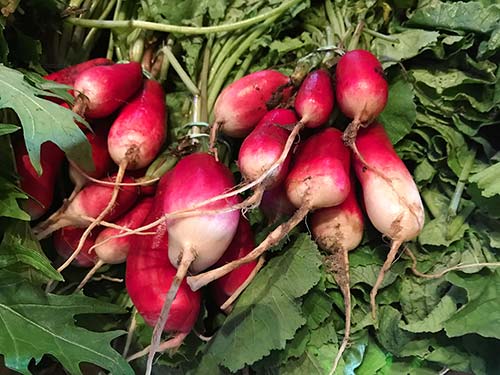RADISHES
Radishes are edible root vegetables of the family Brassicaceae, commonly known as the mustard family. Their skin can range from brilliant red to blazing pink to creamy white to deep black, with creamy white centers. Radishes have a crisp texture and a flavor profile that spans the gamut from mild and sweet to sharp and peppery. Generally, the mildness or sharpness of flavor depends on how long the radish has been growing. The longer it takes radishes to mature the spicier the flavor tends to be. Radish tops are also delicious and full of nutrients and can be used as a salad or cooking green.
Varieties in Your Share

Cherriette Radishes

Daikon Radish

French Breakfast Radishes

Watermelon Radish
Radish roots: Store in the crisper drawer of your refrigerator for up to a week. Remove the leafy tops when you get home, as keeping them intact will increase the rate of moisture and nutrient loss from the root during storage. If the radishes get limp, you can easily revive them by soaking in cold water for 30-60 minutes. Watermelon radishes should also be refrigerated and will store longer, like turnips.
Radish tops: Cut the tops from the root when you get home, and store in a plastic bag with holes in the crisper drawer for 2-3 days. Put a paper towel in the plastic bag to absorb excess moisture. Like other delicate greens, keep them away from the colder spots in your refrigerator to avoid freezing the leaves.
Preserving: Radishes do not freeze well. The best way to preserve them for longer life is to pickle them.
Radishes are often consumed raw as a snack or in salads, but they are quite delicious cooked as well. Cooking radish roots tempers their spice, brings out their sweetness, and softens their texture.
Radishes can be eaten root-to-tip. The green tops are tasty and higher in nutrients than the root, and can be eaten raw or sautéed in a little olive oil or butter.
Late in the fall, we see the mild, delicate daikon radish. Daikons are super versatile and can be enjoyed raw, cooked, or pickled. Then there’s the stunning pink-and-green striped watermelon radish. It’s great sliced very thinly (use a mandoline if you have one) with a little sea salt and creamy spring onion dip.
Scrub radish roots with a vegetable brush, as you would any root vegetable. Summer radish varieties and watermelon radishes do not need to be peeled, but daikon radishes should be peeled.
Radish greens need to be washed thoroughly, as they grow only a few inches from the ground and may have a good deal of soil on them. To wash, fill a bowl with cool water and add the greens. Swish them back and forth with your fingers to loosen the soil and grit. Take the greens out and pour the dirty water out of the bowl, taking care to ensure there is no grit left at the bottom. Refill the bowl with cool water and repeat until there is no more grit sinking to the bottom. Once clean, spin the greens in a salad spinner or dry off with a towel.
Radishes can be eaten raw, cooked, or pickled. Raw, they are lovely as part of a seasonal crudité platter, sliced or grated into salads or slaws, or simply served with butter. To reduce the spice of a raw radish, cut or slice it and sprinkle with a little salt. In traditional Mexican dishes like tostadas, sopes, enchiladas, tacos, and pozole, sliced radishes are often used as a garnish to add brightness to rich, meaty dishes.
Cooking radishes transforms them into a more mellow and sweet vegetable, with a softer texture. They can be pan seared, sautéed, braised, roasted, poached, or even grilled, like any other root vegetable.
Radish tops, sometimes called radish greens, are a great addition to salads or can be used as a cooking green. They are great in a stir fry. They cook quickly, so take care not to overcook. To enjoy radish greens without a recipe, you can simply add them to a salad or mix with other cooking greens (depending on the other greens you are using, it may make sense to add the radish greens towards the end, as they are rather tender).
RECIPES
MISC
Summer radish varieties are a good source of fiber and vitamin C, and contain smaller amounts of copper, potassium, and folate (B9). They are very low calorie and have a high water content.
Radish greens have a more significant nutritional value than the roots – they are higher in calcium, vitamin C, fiber, and antioxidants. They also contain a good amount of vitamin B6, magnesium, phosphorus, iron, and vitamin A.
Daikon radishes are a good source of vitamin C, fiber, and copper, and also contain potassium and folate (B9). They are also very low calorie with a high water content.
Sources: Source 1, Source 2, Source 3
The root skin color of radishes can range from white to pink, as well as red, purple, yellow and even green to black. The flesh tends to be white, but in some varieties like watermelon radishes and certain spring varieties it is white striated with pink.
More info on specific cultivars we receive coming soon
Radishes are fast-growing cool-weather crops, making appearances in the spring and fall, as they do not grow well in the heat of summer. We tend to see them in the first few and last few weeks of our vegetable shares. Radishes grow very quickly, and generally take just three or four weeks from seeding to harvesting for most varieties.
The word radish comes from the Latin radix, meaning “root.”
First domesticated in Asia during pre-Roman times, it was one of the first European crops introduced to the Americas. Radishes also have cultural significance in Russia, Japan, Korea, and Mexico.
The amount of spice in a radish is correlated with the amount of mustard oil produced by the plant in conditions of heat or drought. Mustard oil is the plant’s natural defense mechanism against pests, which tend to prey upon it in this “weakened state.”
Sources: From Asparagus to Zucchini by Fairshare CSA Coalition [https://www.goodreads.com/book/show/652286.From_Asparagus_to_Zucchini] and Ruffage by Abra Berens [https://kitchenartsandletters.com/product/ruffage/].

